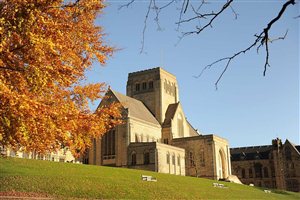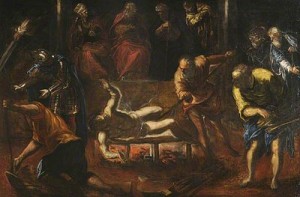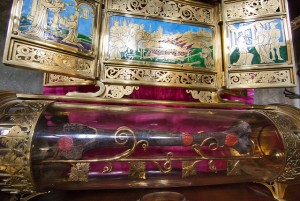This coming Saturday, 10 August, the Church celebrates the feast of St. Lawrence, thought to be one of the truly great martyrs of the early Church. Although his life was distant, geographically and in time, from we humble Christians in Leyland, there is a much closer and rather interesting connection with the Benedictine Monks of the Ampleforth community; consequently, also, with our Parish.
The English Benedictines had been dissolved by Henry VIII in the 1530′s, but one monastery was re-formed at Westminster Abbey by the Catholic Queen Mary; just a few years later, this was dissolved by Queen Elizabeth I. So much for the to’s and fro’s of the Reformation, and so, by the early 1600’s only one of the Westminster monks was left alive – Fr Sigebert Buckley. He professed a group of English monks in France, and so passed onto them all the traditions of the old English Benedictine Congregation. In 1608, these English monks took up residence in an abandoned church of St. Lawrence at Dieulouard, northern France. So it came to pass that, later, when the monks were required to leave France to escape the violence leading up to the French Revolution, they were welcomed to North Yorkshire by Fr Anselm Bolton, Chaplain to the late Lady Anne Fairfax of the nearby Gilling Castle. He was then living at Ampleforth Lodge. In 1802, this became the monks’ new monastery. The French connection has been, and is still maintained, today, by virtue of the adoption of St. Lawrence as the Patron Saint of the Ampleforth Community.
 |
The Abbey Church of St. Lawrence, Ampleforth
St. Lawrence, it is believed, was born, (circa. 225) in Northern Spain, at Huesca, in the foohills of the Pyrenees. Whilst still a youth and completing his studies at Zaragoza, he met the future Pope Sixtus II, who became one of his highly esteemed teachers. At the end of his studies, Lawrence and Sixtus travelled from Spain to Rome. Sixtus was made Pope in 257, whereupon he ordained Lawrence as a deacon of the Church – chief among seven deacons – and Archdeacon of Rome, a position of great trust, as he was given responsibility for the care of the treasury and the valuables belonging to the Church at that time. It was also his job to look after the giving of alms to the poor.
Then in Rome, it was the norm for any denounced Christian to be executed, their goods to be seized and taken over by the imperial authorities. Reinforcing this norm, it is recorded that, at the beginning of August, 258, the Emperor Valerian issued an order calling for the immediate execution of all bishops, priests and deacons of the Church and Pope Sixtus II was one of the first to fall foul of this order. During his celebration of the liturgy, he was captured on August 6, 258, and beheaded.
The Prefect of Rome then ordered Lawrence to hand over the treasures of the Church, at which command, Lawrence is said to have asked for three days in which to assemble these before being able to hand them over. In the three days, he worked tirelessly to distribute these riches to the poor, and on the appointed day, he appeared before the Prefect with the assembled poor, the crippled, the blind, the sick and the lame behind him, saying to the Prefect that these were the ‘true’ treasures of the Church, and declaring “The Church is truly rich, far richer than your Emperor.” This act of defiance led directly to his own martyrdom, recorded as taking place on August 10, 258.
Legend has it that Lawrence was executed by being roasted alive on a grid-iron. However, on this point, there has been much disagreement and whilst some authorities still maintain he was killed in this way, others point out that his death was much more likely to have been by means of a sword-thrust to the throat, or by decapitation, these latter means being more in keeping with the Imperial order requiring immediate execution.
 |
The Martyrdom of St. Lawrence - Tintoretto
Broaching the question of this blog with Father Jonathan, he was very much in favour of such an attempt. After a little research, I was able to put together a précis of the historical background, which found favour with Father, but he was then able to bring the whole subject much ‘closer to home’, with his more ‘personal’ knowledge of many aspects pertaining to Ampleforth’s Patron Saint. I am, therefore, very much indebted to Father Jonathan for his following most valuable supplement, which, of course, converts this blog, very much, into a joint enterprise.
Socius
Fr. Jonathan writes:
“Politics provides the close, and very important association, Ampleforth Abbey with St. Lawrence. The King of Spain in 1608 was Philip III. He had heard of the ‘fledgling’ English Benedictine community at Dieulouard, and he was the Catholic ‘champion’ of Europe. England was a powerful country but, religiously, did not form part of ‘Catholic Europe’, and a state of enmity still existed between the two countries; remember that the Spanish Armada – an expedition designed to overthrow Elizabeth I and her Protestant policies – had floundered twenty years previously.
However, to Dieulouard, King Philip sent a relic consisting of one of St. Lawrence’s bones, hitherto kept by him in the “Escorial”, his Royal Palace in Spain, (incidentally, also bearing the name of San Lorenzo). The “Escorial” is built in the shape of the ‘grid iron’ on which St. Lawrence is thought, by many, to have died. This relic (with authentication from Rome), is still kept at Ampleforth to this day.
 |
Relic of St Lawrence at Ampleforth Abbey
On the Feast Day of St. Lawrence, the First Reading is from 2 Corinthians 9, wherein one finds the clause: “God loves a cheerful giver”. For me, as one of the monks of this “Lawrentian community”, I have often reflected that this phrase has been expressed in the lives of many of my brother monks.
Take, perhaps, its most famous son, St. Alban Roe, an Ampleforth monk, put to death in the usual most cruel fashion, on January 21 1642. He was for many years in prison and yet free to go out in London and minister to the people – a rather strange arrangement! He was always cheerful and used to play cards with the prisoners and others. That clause, from the First Reading of the Feast Day of the Patron Saint of his Abbey ‘strikes home’ with him; it must have been well known to him.
I have known many monks in my life-time, and one characteristic is their cheerfulness in the giving of self. One student at our High School, who went recently to Ampleforth, told me that what struck him – and his friends – was the goodness, kindness and the cheerfulness of the monks. St. Lawrence had the very same reputation.
Over many years now, I recall the sight of my brother monks, kneeling at this relic, which is kept at the right-hand side of the altar, and praying fervently to St. Lawrence. Such devotions continue to this day. He is a living memory for us, and on Saturday next, it will be a great feast day for our Ampleforth monks.”
Father Jonathan
